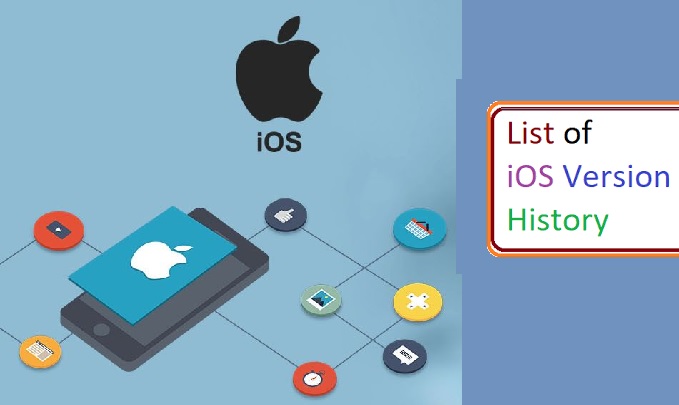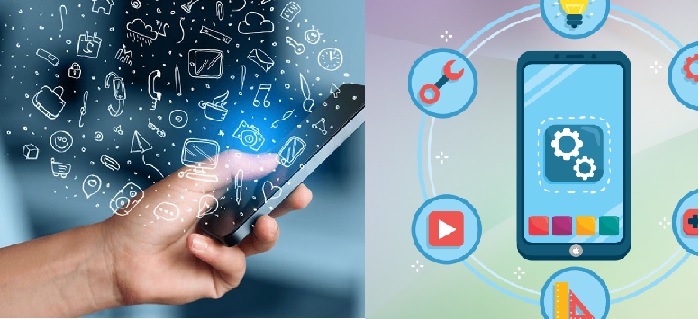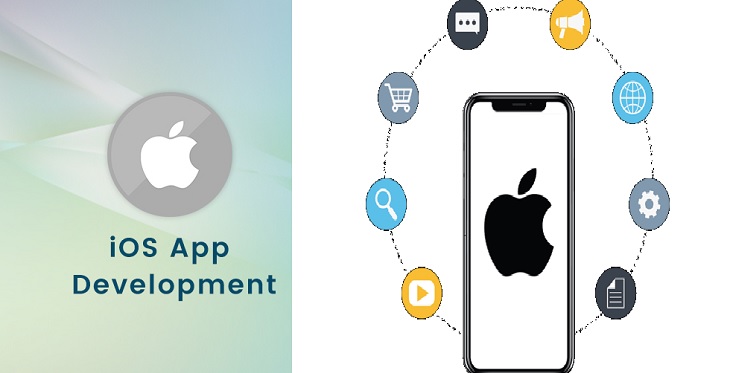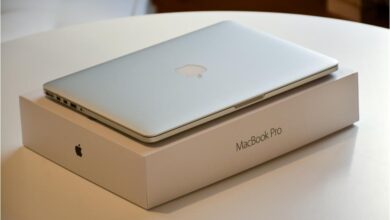iOS Platform: A Complete And Informative Overview

How and why that exactly is iOS?
Let’s take a look at the iOS platform. iPhone, iPod Touch, and iPad all run iOS, Apple’s unique operating system. Operating systems for the iPhone Objective-C, C, C++, and Swift are all supported by iOS. It is based on the Macintosh OS X operating system. IOS is included with iPhone, iPod touch, and iPad. As a result, smart wristbands: Apple Watch are being targeted. As a result, The iOS platform is popular, especially when considering iOS app development cost.
What Is an iOS Platform?
The iPhone operating system platform is abbreviated as the iOS Platform. It is Apple’s own mobile operating system for its portable devices. Programming languages Objective-C, C, C++, and Swift are all supported. It is predicated on the Macintosh OS X operating system. It is the world’s largest and second most widely used desktop system, after Android.
This operating system is used by several of Apple’s mobile devices, including that of the iPhone, iPad, and iPod. iOS Platform uses a multi-touch experience to operate the device, such as dragging the finger on the screen to progress towards the next page or squeezing the fingers to zoom in and out.
Features Of the iOS Platform
Multitasking
The iPhone has multitasking capabilities. It all began with the iPhone 4, then the iPhone 3GS. Anyone can quickly switch from one app to another while using the multitasking function on an iOS Platform device or a multi-finger motion on an iPad.
Social Media
Sharing content and presenting an activities feed is really just two of something like the ways the iOS Platform makes integrating social network interactions into the app straightforward.
iCloud
Apple’s iCloud program is a cloud-based data storage solution. It functions on all Apple devices it has some Windows interoperability, and it runs in the background for most functions. It is quite secure. It includes a backup feature to ensure that security and privacy are not lost.
In-App Purchase
In-app purchases, which seem to be accessible on all Apple platforms, give users access to various networks and applications inside the app, including digital products (iOS, iPad OS, macOS, watch OS), subscriptions, and additional content. Companies may also focus on marketing in-app purchases through the App Store.
Game Center
Apple’s social gaming network, Game Center, enhances the enjoyment and interaction users get from playing games. Scoreboards, badges, multiplayer, a dashboard, and other features are available through the Game Center.
Notification Center
Notification Center is an iOS platform feature that collects all of the app alerts and displays them in one place. It provides alerts again until the customer completes a connected activity, but instead of requiring an instant response. The notification options, on the other hand, are within their control.
Accelerometer
A device that measures variations in velocity somewhere along a single axis is known as an accelerometer. Every iOS platform device has a three-axis accelerometer that provides acceleration measurements in every one of the three axes. The LIS302DL 3-axis MEMS-based accelerometer was utilized in the first-generation iPhone and iPod touch.
Gyroscope
A gyroscope measures the rate at which a device rotates around with a geographical axis. Many iOS platform devices have a three-axis gyroscope, which offers rotational information for each of the three axes.
GPS
The iPhone has an integrated Assisted GPS (AGPS) chip that detects the location. This feature has already been built into the iPhone, and there is no need to install it. This method is faster than standard GPS since it delivers an estimation of the location derived from satellite data.
Accessibility
Every Apple device and service includes one-tap accessible features that work in the same way users would.
Bluetooth
The Fundamental Bluetooth framework has been established by Apple, and it offers classes for communicating with Bluetooth-enabled low-energy wireless communication technology.
Orientations
The landscape and panorama orientations are supported by the iOS Platform apps. In XCode, Apple, but at the other extreme, supplies particular emphasis for designing portrait and landscape layouts.
Camera Integration
The AV Foundation Acquisition Sub-system, which would be a typical high framework for audio, image, and recording videos, is included in the iOS platform.
Location Services
With the user’s consent, Location Services allows sites and apps to access the user’s position of the device. The progress bar boasts a black or white arrow icon while location services are active.
Maps
Apple provides an online navigation service that could be used as the default map platform for iOS platform devices. It offers a number of features, including a flyover mode. Apple’s Map Kit can be used to construct map-based programs.

History Of the iOS Platform
The iPhone was introduced in June 2007, then on September 5, 2007, Apple announced the iPod Touch, which has most of the iPhone’s non-phone features. Apple renamed the iPhone OS to the iOS platform in June 2010. The original iPad was published in April 2010, followed by the iPad Mini in November 2012.
iOS Releases
| Release | Description |
|---|---|
| Introduction to iOS 14 | This document describes Xamarin.iOS 14. |
| Introduction to iOS 13 | This document describes Xamarin.iOS 13. |
| Introduction to iOS 12 | This document describes iOS 12 features available for use when building Xamarin.iOS applications. |
| Introduction to iOS 11 | iOS 10 includes several new APIs and services that allow you to develop apps with new features and functionality. With iOS 10, apps have new abilities such as extending Maps, Messages, Phones and Siri. This section shows how to take advantage of these features in Xamarin. iOS app. |
| Introduction to iOS 10 | This section defines the changes made in iOS 9 when upgrading from iOS 8 and how to use these features in an Xamarin.iOS app. |
| Introduction to iOS 9 | This section defines the changes made in iOS 9 when upgrading from iOS 8 and how to use these features in a Xamarin.iOS app. |
| Introduction to iOS 8 | iOS 8 made a large number of changes to the operating system from iOS 7. Here, we show what they are and how to use them. |
| Introduction to iOS 7 | About the major new APIs introduced in iOS 7, including View Controller transitions, enhancements to UIView animations, UIKit Dynamics, and Text Kit. |
| Introduction to iOS 6 | Explanations of the features introduced in iOS 6, including Collection Views, Pass Kit, Event Kit, and the Social Framework. |

iOS 1
| Support ended | 2010 |
| Final Version | 1.1.5. It was released on July 15, 2008 |
| Initial Version | It was released on June 29, 2007 |
Key Features
- Visual Voicemail
- Multitouch interface
- Safari browser
- Music app
iOS 2
| Support Ended | 2011 |
| Final Version | 2.2.1. It was released on January 27, 2009 |
| Initial Version | It was released on July 11, 2008 |
Key Features
- App Store
- Improved Maps app
iOS 3
| Support Ended | 2012 |
| Final Version | 3.2.2. It was released on Aug. 11, 2010 |
| Initial Version | It was released on June 17, 2009 |
Key Features
- Copy and paste
- Spotlight search
- Recording videos
iOS 4
| Support Ended | 2013 |
| Final Version | 4.3.5. It was released on July 25, 2011 |
| Initial Version | It was released on June 22, 2010 |
Key Features
- FaceTime
- Multitasking
- AirPlay
- Air Print
- i Books
- Personal Hotspot
Dropped Support For
- Original iPhone
- 1st Gen. iPod touch
iOS 5
| Support Ended | 2014 |
| Final Version | 5.1.1. It was released on May 7, 2012 |
| Initial Version | It was released on Oct. 12, 2011 |
Key Features
- iCloud
- i Message
- Notification Center
- Wireless syncing and activation
Dropped Support For
- iPhone 3G
- 1st gen. iPad
- 2nd gen. iPod touch
- 3rd gen. iPod touch
iOS 6
| Support Ended | 2015 |
| Final Version | 6.1.6. It was released on Feb. 21, 2014 |
| Initial Version | It was released on Sept. 19, 2012 |
Key Features
- Apple Maps
- Do Not Disturb
- Passbook (now Wallet)
Dropped Support For
- None, but the iPhone 3GS, iPhone 4, and iPad 2 couldn’t use all the features of iOS 6
iOS 7
| Support Ended | 2016 |
| Final Version | 7.1.2. It was released on June 30, 2014. |
| Initial Version | 7.1.2. It was released on June 30, 2014. |
Key Features
Activation Lock
AirDrop
Car Play
Control Center
Touch ID
Dropped Support For
- iPhone 3GS
- iPhone 4, iPhone 4S, 3rd gen. iPad, and iPad 2 couldn’t use all features of iOS 7
iOS 8
| Support Ended | 2016 |
| Final Version | 8.4.1. It was released on Aug. 13, 2015 |
| Initial Version | It was released on Sept. 17, 2014 |
Key Features
- Apple Music
- Apple Pay
- iCloud Drive
- Handoff
- Family Sharing
- Third-party keyboards
- Home Kit
Dropped Support For
- iPhone 4
iOS 9
| Support Ended | 2018 |
| Final Version | 9.3.9. It was released on July 22, 2019 |
| Initial Version | It was released on Sept. 16, 2015 |
Key Features
- Night Shift
- Low Power Mode
- Public beta program
iOS 10
| Support Ended | 2019 |
| Current Version | 10.3.4. It was released on July 22, 2019 |
| Initial Version | It was released on Sept. 13, 2016 |
Key Features
- i Message apps
- Delete built-in apps
Dropped Support For
- iPhone 4S
- 5th gen. iPod touch
- iPad 2
- 1st gen. iPad mini
iOS 11
| Current Version | 11.4.1. It was released on July 9, 2018 |
| Initial Version | It was released on September 19, 2017 |
Key Features
- Augmented Reality
- Air Play 2
- Major enhancements on iPad
Dropped Support For
- iPhone 5C
- iPhone 5
- iPad 4
- iPad 3
iOS 12
| Current Version | 12.4.8. It was released July 15, 2020 |
| Initial Version | It was released on September 17, 2018 |
Key Features
- Grouped Notifications
- Screen Time
- ARKit 2
- Siri improvements, including Siri Shortcuts and multi-step actions
- Memoji, a personalized kind of Animoji
iOS 13
| Current Version | 13.7, release Sept. 1, 2020. |
| Initial Version | 13.0, released Sept. 19, 2019 |
Key Features
- System-wide Dark Mode
- Sign In With Apple user account system
- New privacy and security options
- New Portrait Lighting options
- Look Around, a Google Street View-style feature for Apple Maps
- New, improved Siri voice
- Overhauled stock apps like Reminders and Notes
Dropped Support For
- iPad (due to the release of iPad OS)
- 6th Gen. iPod touch
- iPhone 6 series
- iPhone 5S
iOS 14
| Current Version | 14.6, released May 24, 2021 |
| Initial Version | 14.0, released Sept. 17, 2020 |

Key Features
- Home screen Widgets for customized home screens and shortcuts.
- Smart Stacks that deliver different Home screen Widgets at different times of the day based on your habits.
- Set third-party apps as default for email and web browser apps.
- App Library, a new way of organizing apps and keeping your home scree neat
- App Clips
- Picture in picture mode
- Improved privacy features to block tracking online.
- Built-in language translation for 11 languages.
- Spatial audio for Air Pods delivers surround sound, along with other Air Pods improvements.
- Design changes allow phone calls and FaceTime calls to take up less space on the screen and allow you to do other things at the same time.
- Numerous improvements for group texts in i Message, including threaded replies and mentions.
Dropped Support For
- None. iOS 14 supports the same set of devices as iOS 13
iOS 15
| Current Version | 15.0.2, released Oct. 11, 2021 |
| Initial Version | 15.0, released Sept. 24, 2021 |
Key Features
- FaceTime has gotten a slew of updates aimed at boosting the app’s usability and extending its user base.
- Depending on what people are doing at the time, Focus provides a set of smart notifications and conversation options.
- The Photos app has gotten a lot better.
Dropped Support For
- iPhone 6 series. All iPhone models from the 6S series and up are supported.
- 6th Gen. iPod touch. Only the 7th Gen. iPod touch is supported.
How Is iOS Platform Better Than Any Other Platform?
It is quicker, easier, and less expensive to develop for the iOS platform. An android phone app takes 30-40% longer to produce than an iOS platform app. The code is one of the reasons IOS platform is easy to develop.
Android apps are typically created in Java, which is a more code-intensive language. Swift, on the other hand, is Apple’s official language of programming. Swift is a simple language to learn and use. As a result, it requires less time than just about any other platform.
Android is a free and open-source operating system. As a result of the absence of standardization, more gadgets, hardware, and software heterogeneity are required to take responsibility for the Android Play Store.
Because of iOS’s platform contained environment, it only develops for a limited number of standardized platforms and operating systems. As a result, the iOS platform app store has rigorous quality standards and a longer review procedure, which can cause programs to take much longer to be authorized. Furthermore, even if the application meets Apple’s standards, it may be denied.
iOS Platform Facts
- The iPod Touch, iPhone, and iPad are all powered by iOS platform.
- According to the declaration made at the beginning of 2015, 1 billion iOS platform devices were sold.
- In addition, the App Store presently has over 1.4 million apps.
- The operating system that runs the iPod Touch, iPhone, and iPad is the same. It also provides electricity to the Apple TV.
- More than one billion iOS platform devices have already been sold to date. As a result, it’s a staggering figure, particularly considering that the platforms have so far only been accessible for a few years.
- In the years ahead, the new markets of India and China would expand this industry to even higher proportions.
- The App Store currently has approximately 1.4 million apps accessible. For developers, this has been a really popular device.
iOS Platform Overview
The iOS platform architecture is a layered one. At its most basic level, iOS platform serves as a bridge between both the physical infrastructure and the applications that are created. Applications, on the other hand, do not connect directly with the hardware resources. Likewise, apps communicate with hardware via a set of very well systemic approaches.
These protocols make it simple to create apps that work reliably across a variety of hardware platforms.
All applications benefit from the services provided by the lower layers. It, too, is built on the higher mantle and provides a powerful visual interface as well as ancillary activities.
Read Also –Windows Operating System: A Complete Overview
The majority of Apple’s system interfaces are packaged in special packages known as frames. A framework is a subdirectory that includes a programming model library, as well as header files, related pictures, and helper apps, all of which are required to support the library’s contents.
As a result, each layer has its own set of frameworks that perhaps the developer can utilize to create applications. The multilayered construction of the iOS platform is seen here.
Cocoa Touch
Cocoa Touch is an application for developing user interfaces. It’s used to create iOS platform-compatible software.
It serves as an intermediate device for iOS platform, the iPhone, iPod Touch, and iPad operating system. Cocoa Touch, which is developed primarily in Objective-C, is also based on the macOS set of API tools and cocoa. As a result, Cocoa Touch enables the use of hardware and functionality that are not available on Mac OS desktops, making iOS devices unique. Cocoa Touch also follows the Model-View-Controller (MVC) software design.
Cocoa Touch has a distinct set of graphics for control components than cocoa. As a result, the iOS platform SDK of the iOS platform includes tools for developing Cocoa Touch applications.
- Drivers can use the Event Kit Frame to see normal system interfaces. To see and change the events on the calendar, follow the steps below.
- Game Kit Marco — Adds Game Center functionality to Game Kit. As a result, users can share game-related information online.
- i Ad Framework — It allows people to make offers based on the application’s flag.
- Marco from Map Kit generates a displacement map. As a result, it can be incorporated into the application’s user interface.
- Pushkin Framework — The registration enables VoIP applications to run.
- Marco Twitter – It includes a user interface for creating tweets as well as the ability to create URLs to access the Twitter service.
- UI Kit Framework — This framework is essential for creating graphical applications:
- Support for multitasking.
- Basic infrastructure and software administration.
- User interface for management
- Contact as well as movement events are supported.

Media Layer
For the iOS platform operating system The middle layer is used to engage images, audio, and video technology.
Framework For Graphics:
- UI Kit Graphics — This is the highest level of picture development capability. As a result, it is explained and also used to stimulate the substance of their points of view.
- Graphics Core Framework — This is a drawing technology for IOS platform native apps that allows bespoke 2D and renderings based on picture vectors.
- Core Animation is a first-generation technology that improves the animation experience.
- Core pictures — Provides extensive non-destructive functionality for remotely controlled video and still photos. As a result, image management is possible.
- Manage 2D and sophisticated 3D accelerated via hardware interfaces with OpenGL ES and GLKit.
- Metal — Allows for extremely high performance in terms of graphics rendering and sophisticated computer for their work. It has a very low GPU access rate compared to the A7.
Frame Of Sound:
- Media Player Framework — This is a high-level foundation that allows users to easily access the iTunes library and playback playlists.
- AV Foundation – Objective C is a user interface for controlling audio and video recording and playback.
- Open AL is an audio technology that is widely used in the business.
Frame From A Video
- AV Kit – The frame includes a selection of simple video projection interfaces.
- AV Foundation — This software allows for advanced streaming video and recording.
- The low-level interfaces and data formats for controlling the media are described by the framework. As a result, core means are improved.
Core Service Layers
Layer of core services The following are some of the primary clear indication in the layers of essential services:
- Marco Address Book — Provides programmatic access to a user contact database. As a result, keeping records is necessary.
- Cloud Frame Kit — Allows you to transfer data between your app and iCloud.
- The basic data framework — A Model – View – controller application’s data model for information systems.
- The interfaces that offer managerial functions, vital data, and application services for iOS platform are known as the Core Foundation architecture. As a result, essential foundation facilities are provided.
- The location and direction knowledge apps are part of the Core Location framework.
- Obtain all data depending on movies and shows on a device using core frame motion. Movement can be retrieved and use this knowledge architecture based on the accelerometer’s core.
- Foundation Framework – Objective C, which includes many of the capabilities found in the Core Foundation framework.
- Health kit framework — A new framework for storing and managing information on users’ health.
- Home kit framework — A new framework for communicating with and controlling connected gadgets in a user’s home.
- Social framework – A simple user interface for accessing users’ social networking accounts.
- Store Kit frame — allows users to buy content and services directly from within their iOS platform apps, a feature known as ASIN-App Purchase.
Core OS Layer
IOS platform is immediately on upper edge of the physical device, and the core layer OS is the last layer of the stack. This layer also supports a number of services, such as low-level communication access to international peripherals and standard services like dynamic memory, system files managerial staff, and basic operating systems threads.
The operating system’s fundamental layer has traits with the low-level technology that many other technologies are built on:
- The core of the Bluetooth Framework is the Accelerate framework.
- Marco’s external add-on
- Security services provided by the framework
- 64-bit support for the local understanding the structure iOS7 allows the development of 64-bit programs, which allows for faster performance metrics.
The following functions are provided by the core OS layer:
- Threading
- Standard I/O Security
- Services
- Networking
- To summaries, the top layers (Cocoa Touch) have a relatively SIMPLE degree of functionality, and as we move down to Core OS, the amount of code we write and the complexity of the code generally rises.
Android Vs. iOS Platform
| Features | Android | iOS Platform |
| current rating | 4.14/5 | 3.92/5 |
| Developer | Various, mostly Google and Open Handset Alliance | Apple Inc. |
|---|---|---|
| Initial release | September 23, 2008 | July 29, 2007 |
| Latest stable release and Updates | Android 11 | iOS 14.1 and iPadOS 14.1 |
| Customizability | Quite a bit. Almost everything can be changed. | Even if are jailbroken, the options are limited. |
| Source model | Open source | Closed, with open source components. |
| File transfer | It’s a lot easier than iOS. Using the Android Data Migration desktop app and a USB port Without the use of programs, photos can be transferred via USB. | It’s getting tougher. The iTunes desktop program can be used to transfer media files. Without the use of any programs, photos can indeed be downloaded to a USB drive. |
| Widgets | Yes, except on lockscreen | Yes, except on lockscreen |
| Internet browsing | Chrome is a web browser developed by Google (other browsers are available). Any browser application can be made the default. Firefox has a built-in ad blocker. | Safari. Any browsing app can be made the default, but behind the scenes, they all use the same rendering engine (Safari/Web kit). Content filters, such as Firefox Focus, support ad blocking. |
| Web mapping service | Google Maps | Apple Maps (default). Google Maps is also accessible as a standalone app, although not as the default. |
| Available language(s) | 100+ languages | 40 languages |
| Video chat | Google Meet and other 3rd party apps | FaceTime (Apple devices only) and other 3rd party apps |
| Virtual assistant | Google Assistant | Siri |
| Available on | There are numerous phones and tablets. Samsung, Oppo, OnePlus, Vivo, Honor, and Xiaomi are among the top smartphone makers. Android One smartphones are fully functional Android devices. Google’s Pixel range of devices runs on a nearly stock version of Android. | Apple TV, iPod Touch, iPhone, iPad (2nd and 3rd generation) |
| Calls and messaging | Google Messages is a messaging service provided by Google. Facebook Messenger, WhatsApp, Google Duo, Discord, and Skype are all third-party apps that function on both Android and iOS. | FaceTime, i Message (with other Apple devices only). Google Hangouts, Facebook Messenger, WhatsApp, Google Duo, Discord, and Skype are examples of third-party apps that function on both Android and iOS platform. |
| App store , Affordability and interface | There are almost 2,000,000 apps in the Google Play Store. Android apps are also available on other app stores such as Amazon and Aptoide. (“.APKs”). Virus-infected apps are uncommon, although they do occur. | There are over a million apps in the Apple App Store. Virus-infected apps are extremely rare or non-existent. |
| Alternative app stores and side loading | Additional than the official Google Play Store, there are other other app stores to choose from. Aptoide, Galaxy Apps, etc.) | Apple prohibits the use of third-party app stores. If anyone wish to download apps from other shops, people will need to jailbreak the phone. |
| Battery life and management | Many, but not all, Android phone makers include huge, long-lasting batteries in their smartphones. | Apple batteries are generally not as big as the largest Android batteries. However, Apple is able to squeeze decent battery life via hardware/software optimizations. |
| Open source | Kernel (Based on Linux), UI, and some standard apps | The iOS kernel is not open source but is based on the open-source Darwin OS. |
| File manager | Yes. (Stock Android File Manager included on devices running Android 7.1.1) | Files app, limited and less useful (iOS 12). |
| Photos & Videos backup | Apps for automatic photo and video backup are available. Google Photos allows users to save an infinite number of photos in a compressed format. Other options include OneDrive, Amazon Photos, and Dropbox. | iCloud can automatically back up up to 5 GB of photographs and videos, with additional paid iCloud storage accessible via subscription. Google, Amazon, Dropbox, Flickr, and Microsoft, among others, have auto-backup apps for both iOS and Android. |
| Security | Security updates are released on a monthly basis. Pixel device owners will be the first to receive Android OS updates. Manufacturers are notorious for being slow to release these upgrades. As a result, the great majority of Android smartphones are running obsolete OS software at any given time. | Security upgrades on a regular basis. Because iOS is encrypted and obtaining apps from the App Store is difficult, security issues are infrequent. |
| Rooting, bootloaders, and jailbreaking | Users have full access to and control over the device, as well as the ability to unlock the bootloader. | Users don’t have complete control of the gadget. |
| Cloud services | Google Drive storage is natively integrated. 15GB is free. Apps for Amazon Photos, OneDrive, and Dropbox are all available. | iCloud integration is native. 5GB is free. Google Drive and Google Photos, Amazon Photos, OneDrive, and Dropbox all have apps. |
| Interface | Touch Screen | Touch Screen |
| Biometric Authentication | Authentication by fingerprint and/or face. The hardware of the manufacturer determines availability. | Authentication by fingerprint or by face. Touch ID is available on iPhone 5s and subsequent models, as well as iPad Air 2 and later models, but not on iPhone X and later models. Face ID, which replaces Touch ID on iPhone X and later, is now available. |
| OS family | Linux | OS X, UNIX |
| Headphone Jack | Some modern Android smartphones include this feature, whereas others do not. | None on iPhone 7 and after, and after the iPhone XS, illumination to 3.5mm is no longer included. |
Conclusion
Today, iOS Platform is becoming a popular platform. Anyone can make a lot of money by developing an app for the iOS Platform. Additionally, potential clients use iOS apps. As a result, it might provide people with financial benefits in addition to fame.
FAQ
What is iOS platform?
Apple Inc. created mobile operating system known as iOS. All Apple products: iPhones, iPads, and iPod Touches, use this operating system.
What devices are compatible with iOS?
iOS is compatible with all Apple products:
- iPhone,
- iPad,
- And iPod Touch.
What are main features of iOS?
Some of main features of iOS: user-friendly interface, seamless integration with other Apple devices, ability to use Siri voice commands, access to App Store, and regular software updates.
What is latest version of iOS?
As of April 2023 latest version of iOS is iOS 16.3.
How do I update my iOS device?
To update your iOS device:
- Go to Settings
- Click on General
- Click on Software Update
- If there is an update available you will be prompted to download and install it.
Can I customize look and feel of my iOS device?
Yes, you can customize look and feel of your iOS device by
- Changing wallpaper,
- Rearranging app icons,
- And creating app folders.
Can I use third-party apps on my iOS device?
On your iOS device you can use App Store to download and run third-party apps.
What is AirDrop and how does it work?
Using AirDrop feature: you can wirelessly transfer files between Apple devices. To use AirDrop: both devices need to be in close proximity to one another, with Bluetooth and Wi-Fi turned on.






